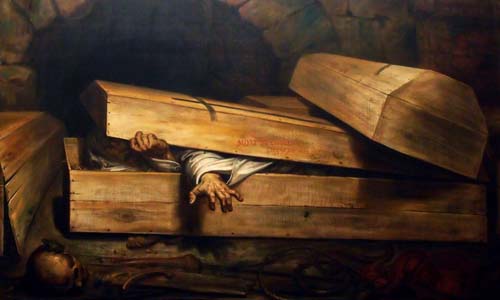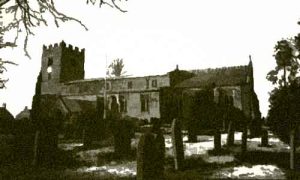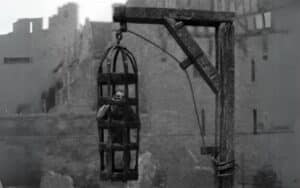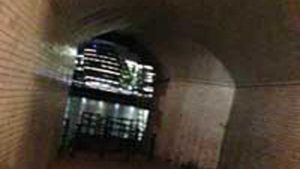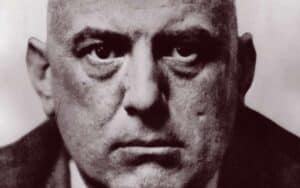STEPHEN JACOBS lookspremature burial in England with tales of victims who lived to tale their terrifying tale!
In my youth (back when there were only three television channels here in the UK), there were two films that played that had scenes in them that gave me the heebie jeebies.
The first was the early scene in David Lean’s Dr. Zhivago, where the young Yuri Zhivago attends the funeral of his mother. Little Yuri watches as the pall bearers place the open coffin on the ground. The lid is nailed on, the coffin is lowered into the earth and, as the wind blows the leaves from the trees, the grave is filled in. Lean then cuts to a shot of Yuri’s mother lying within her coffin. It was a single shot of only five or six seconds but it was enough to give me the willies. Urgh … but at least she was dead.
Residing on the wonderful archive.org site, amongst it wealth of out of copyright texts, is a fascinating tome for those who have an interest in such things: Premature Burial and How It May Be Prevented with special reference to trance, catalepsy and other forms of suspended animation by William Tebb, F.R.G.S.and Col. Edward Perry Vollum, M.D. As the title indicates, Tebb and Perry’s 1905 tome informs the reader of practical ways in which to ensure themselves and their loved ones are not buried alive. It also recounts some tales of the lucky … and the not so lucky.
Below are some of the British tales of the “lucky ones” who escaped premature burial that appear in the book:
A writer in the Referee, May 19, 1901, makes the following statement:
“I once, in my childhood’s days, saw a man who had been buried alive in the churchyard attached to St. Paul’s Church, Deptford. It was at the period of the terrible cholera visitation which occurred, as near as I can remember, about fifty years ago. The burial had proceeded as far as the dirt being sprinkled on the coffin when the bystanders thought they heard a noise proceeding from it. The coffin was quickly raised, and it was found that the man had torn the nails of his hands and feet off in his endeavours to get out. He was taken into my father’s house, the Pilot, a public-house now known by another sign, where he was promptly attended to. I saw him about Deptford for years after. Perhaps some old Deptford reader may also remember the circumstances.”
“A lady, living at Holland Road, Kensington, testified that on hearing the news of the loss of her property, she went into violent hysterics for two hours, and then was thought to have died. After being left for twenty-four hours, she was taken out of her bed, rolled on the floor, and needles and pins were stuck in her. Next morning one of the servants, on looking at her body on the bed, thought it moved. The doctor was sent for again, but he certified that she was undoubtedly dead, and so the coffin was ordered. Three hours afterwards her daughter said: ‘I don’t think mother is dead,’ and applied some brandy to the cold lips. ‘Then I came to, said the lady, who added, ‘That was five years ago. I have my death certificate at home!!! Although I could not move, I could hear everything. I heard the men take my measurement for the coffin.”
“That,” said Mr. Arthur Lovell (the hon. sec.) “was a state of trance with which I am rather familiar. What we want are State-appointed certifiers to examine all cases of supposed decease.”
“Another lady in the meeting certified that she knew a girl at Kensington who ‘came to’ after being pronounced dead, and who remembers hearing the doctor say ‘Ah, poor thing, now she is out of her suffering.’”
The Daily Express, of March 20, 1903, and the Daily Mail, of the 9th, give details of the supposed death of a well-known lady, who, with her family, had long resided in the village of Woore, near Keele, North Staffordshire, and who, after having been certified as dead by the local physician, was laid ready for interment:
“All preparations for the funeral had been made, and friends and relatives assembled to take a final farewell. As the mourners watched, the eyes of the lady were seen to open and her lips to move. Life had returned to the supposed corpse. The news of the strange event spread throughout the village and district, and produced the greatest excitement.”
The Undertakers’ and Funeral Directors Journal of May, 1888, narrates an interesting and apparently trustworthy story:
“Mrs. Lockhart, of Birkhill, who died in 1825, used to relate to her grandchildren the following anecdote of her ancestor, Sir William Lindsay, of Covington, towards the close of the seventeenth century: ‘Sir William was a humorist, and noted, moreover, for preserving the picturesque appendage of a beard at a period when the fashion had long passed away. He had been extremely ill, and life was at last supposed to be extinct, though, as it afterwards turned out, he was merely in a “dead faint” or trance. The female relatives were assembled for the “chesting”; the act of putting a corpse into a coffin, with the entertainment given on such melancholy occasions in a lighted chamber in the old tower of Covington, where the “bearded knight” lay stretched upon his bier. But when the servants were about to enter to assist at the ceremonies, Isabella Somerville, Sir William’s great-granddaughter, and Mrs. Lockhart’s grandmother, then a child, creeping close to her mother, whispered into her ear, “The beard is wagging! the beard is wagging!” Mrs. Somerville, upon this, looked to the bier, and, observing indications of life in the ancient knight, made the company retire, and Sir William soon came out of his faint. Hot bottles were applied and cordials administered, and in the course of the evening he was able to converse with his family. They explained that they had believed him to be actually dead, and that arrangements had even been made for his funeral. In answer to the question, “Have the folks been warned?” (i.e. invited to the funeral) he was told that they had that the funeral day had been fixed, an ox slain, and other preparations made for entertaining the company. Sir William then said, “All is as it should be; keep it a dead secret that I am in life, and let the folks come.” His wishes were complied with, and the company assembled for the burial at the appointed time. After some delay, occasioned by the non-arrival of the clergyman, as was supposed, and which afforded an opportunity of discussing the merits of the deceased, the door suddenly opened, when, to their surprise and terror, in stepped the knight himself, pale in countenance and dressed in black, leaning on the arm of the minister of the parish of Covington. Having quieted their alarm and explained matters, he called upon the clergyman to conduct an act of devotion, which included thanksgiving for his recovery and escape from being buried alive. This done, the dinner succeeded. A jolly evening, after the manner of the time, was passed, Sir William himself presiding over the carousals.’”
The Lancet, November 27, 1858, p. 561, cites a remarkable case which was afterwards corroborated in all its details by the surgeon who attended the patient, Mr R. B. Mason, M.R.C.S., of Nuneaton.
“The girl, whose name is Amelia Hinks, is twelve or thirteen years of age, and resides with her parents in Bridge Street, Nuneaton. She had lately appeared to be sinking under the influence of some ill-explained disorder, and about three weeks since, as her friends imagined, she died. The body was removed to another room. It was rigid and icy cold. It was washed and laid out with all due funereal train. The limbs were decently placed, the eyelids closed and penny-pieces laid over them. The coffin was ordered. For more than forty-eight hours the supposed corpse lay beneath the winding-sheet, when it happened that her grand-father, coming from Leamington to assist in the last mournful ceremonies, went to see the corpse. The old man removed a penny-piece, and he thought that the corpse winked! There was a convulsive movement of the lid. This greatly disturbed his composure; for, though he had heard that she died with her eyes open, he was unprepared for this palpebral signal of her good understanding with death. A surgeon is said to have been summoned, who at first treated the matter as a delusion, but subsequently ascertained stethoscopically that there was still slight cardiac pulsation. The body was then removed to a warm room, and gradually the returning signs of animation became unequivocal. When speech was restored, the girl described many things which had taken place since her supposed death. She knew who had closed her eyes and placed the coppers thereon. She also heard the order given for her coffin, and could repeat the various remarks made over her as she lay in her death-clothes. She refused food, though in a state of extreme debility. She has since shown symptoms of mania, and is now said to have relapsed into a semi-cataleptic condition.”
“Dr. Brewer, says the Lancet, of June 2, 1866, p. 6ii, “in the course of the address delivered to the Guardians of St. George’s at St. James’s Hall, adverted to the ‘laying-out’ case at St. Pancras, and dwelt upon the question of suspended animation in a passage which really deserves to be quoted.”
“I have been more than once under a condition of apparently suspended respiration, and with circumstances less comfortable than those related of this babe; and yet, active as is my brain, and sensitive as is my body, I remember as well as though it were but yesterday that, on being restored to consciousness, no feeling of discomfort of any kind attended my experience on either occasion. It is under the truth to say I have known a score of cases of those who have been supposed dead being reanimated. It is not many months ago a friend of mine, a rector of a suburban parish, was pronounced by his medical attendant to be dead. His bed was arranged, and the room left in its silence. His daughter had re-entered and sat at the foot, and the solemn toll of his own church bell was vibrating through the chamber, when a hand drew aside the closed curtain, and a voice came from the occupant of the bed ‘Elizabeth, my dear, what is that bell tolling for?’ The daughters response was, perhaps, an unfortunate one: ‘For you, Papa.’
On July 2, 1896, the author visited the grave of Madam Blunden, in the Cemetery, Basingstoke, Hants, who, according to the inscription (now obliterated), was buried alive. The following narrative appears in The Uncertainty of the Signs of Death, by Surgeon M. Cooper, London, 1746, pp. 78, 79:
“At Basingstoke, in Hampshire, not many years ago, a gentlewoman of character and fortune was taken ill, and, to all appearances, died, while her husband was on a journey to London. A messenger was forthwith despatched to the gentleman, who returned immediately, and ordered everything for her decent interment. Accordingly, on the third day after her supposed decease, she was buried in Holy Ghost Chapel, at the outside of the town, in a vault belonging to the family, over which there is a school for poor children, endowed by a charitable gentleman in the reign of Edward VI. It happened the next day that the boys, while they were at play, heard a noise in the vault, and one of them ran and told his master, who, not crediting what he said, gave him a box on the ear and sent him about his business; but, upon the other boys coming with the same story, his curiosity was awakened, so that he sent immediately for the sexton, and opened the vault and the lady’s coffin, where they found her just expiring. All possible means were used to recover her to life, but to no purpose, for she, in her agony, had bit the nails off her fingers, and tore her face and head to that degree, that, notwithstanding all the care that was taken of her, she died in a few hours in inexpressible torment.”
A solicitor, living in Gloucester, recently informed the editor that, when first in practice, he had as caretaker of his offices an old woman who, with her husband, had been in charge of the cholera wards, erected just outside the city, at the time of the severe epidemic of 1849, when, in Gloucester alone, there were 119 fatal cases. She told him that as soon as the patients were dead they put them in shells and screwed them down, so as to get them out of the way as quickly as possible, as the small sheds (which are still standing) were so crowded. “Sometimes,” she callously remarked, “they come to afterwards, and we did hear ’em kicking in their coffins, but we never unscrewed ’em, ’cause we knew they’d got to die!”
The following appeared in Truth (London), on May 23, 1895; it forms but an example of many similar instances of which the writer has heard:
“The other day I gave a story showing the difficulty of obtaining a post-mortem examination after a doctor has once certified the cause of death. One of my readers caps it with a gruesome narrative of which this is the outline: A man lately died in London. The coffin had to be removed by rail, and was to be closed on the fourth day after the death. My informant, taking a last look at the deceased, was struck by the complete absence of all the ordinary signs of death at such a period. In particular, he states that there was no rigidity in any part of the body, and there was a perceptible tinge of colour in the forehead. He went over to the doctor who had attended the deceased, described all the signs that he had observed, and begged him to come and look at the body before the coffin was closed. The doctor absolutely refused, saying that he had given his certificate, and had no doubt as to the man’s death. The friend then suggested that he might himself open a vein and see if blood flowed, to which the doctor replied that, if he did so without the authority of the widow, he would be indictable for felony. ‘Whereupon,’ says my informant, who was only a friend of the family, ‘I had to retire baffled, and let matters take their course.’ Why on earth he did not take the widow into his confidence, or risk an indictment for felony by opening a vein on his own account, or even summon another doctor, he does not say. I trust that, should any friend of mine see my coffin about to be screwed down under similar circumstances, and find equal cause to doubt whether I am dead, he will summon up courage to stick a pin into me, and chance the consequences. This, however, has nothing to do with the doctor’s responsibilities. It would seem that the medico in this case was either so confident in his own opinion as to decline even to walk across the road to investigate the extraordinary symptoms described to him, or else that he preferred the chance of the man being buried alive to the chance of having to admit he had made a mistake. Which alternative is the worst I do not know.”
One person wrote of his proposed solution to premature burials:
“If people must be buried before they begin to show signs of putrefaction (which seems to be the only reliable proof that life is really extinct), why not shorten their sufferings, in case of resuscitation, by opening an artery before they are buried? There is still much prejudice against the cremation of dead bodies, although two great facts are decidedly in its favour viz., the impossibility of recovering consciousness when once inserted in the crematory oven, and the prevention of the unhealthiness which the slow process of putrefaction must entail. Yours, etc.,”
Cases like the following which appeared in the London Echo, of January 29, 1901, are sufficient to arouse alarm in any sensitive nature. This journal reports that “some workmen, opening a vault at Ghent yesterday, were horrified to discover the body of a young girl lying across the steps leading down into the vault. She was quite dead, and had evidently been buried in a trance.”
The London Globe, October 26, 1896, mentions the following case:
“A soldier’s wife was reported by a military surgeon to have died during her confinement. She was buried on his certificate of death; but about two days afterwards the baby to whom she had given birth was also reported dead. The mother’s coffin was then disinterred and opened, with the view of placing the deceased baby in it; but, horrible to relate, it was discovered by only too evident signs that the woman had been buried alive, and had recovered consciousness after burial.”
The Undertakers’ Journal, November 22, 1880, relates the following:
“An extraordinary story is reported from Tredegar, South Wales. A man was buried at Cefn Golan Cemetery, and it is alleged that some of those who took part in carrying the body to the burial-ground heard knocking inside the coffin. No notice was taken of the affair at the time, but it has now come up again, and the rumour has caused a painful sensation throughout the district. It is stated that application has been made to the Home Secretary for permission to exhume the body.”
Mr. William Harbutt, School of Art, Bath, writes to me, November 27, 1895:
“The copies of the pamphlet The Perils of Premature Burial, by Professor Alex. Wilder, you kindly sent me are in circulation. Almost everyone to whom I mention the subject knows some instances. One, a case at Radstock, twelve miles from Bath, where the bearers at the funeral heard noises inside the coffin, but were afraid to open it without the authority from a magistrate. When it was opened next day the appearance of the body showed that he had been coffined alive, and had had a terrible struggle to escape.”
Which beggars the question … how is premature cremation any better than premature burial? And this brings us to my second ‘heebie jeebie’ scene … Diamonds Are Forever. James Bond (Sean Connery) is knocked unconscious and awakens in a coffin … in the funeral oven. As he kicks out trying to get free, the flames lick the outside of the coffin. Urgh!
To conclude this shiversome subject, don’t forget to check out two other famous works on the subject: Edgar Allan Poe’s story The Premature Burial and Roger Corman’s film of the same name below.

